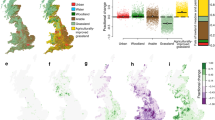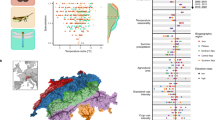Abstract
Interpretation of global biodiversity change is hampered by a lack of information on the historical status of most species in most parts of the world1,2,3,4,5. Here we show that declines and increases can be deduced from current species distributions alone, using spatial patterns of occupancy combined with distribution size. Declining species show sparse, fragmented distributions for their distribution size, reflecting the extinction process; expanding species show denser, more aggregated distributions, reflecting colonization. Past distribution size changes for British butterflies were deduced successfully from current distributions, and former distributions had some power to predict future change. What is more, the relationship between distribution pattern and change in British butterflies independently predicted distribution change for butterfly species in Flanders, Belgium, and distribution change in British rare plant species is similarly related to spatial distribution pattern. This link between current distribution patterns and processes of distribution change could be used to assess relative levels of threat facing different species, even for regions and taxa lacking detailed historical and ecological information.
This is a preview of subscription content, access via your institution
Access options
Subscribe to this journal
Receive 51 print issues and online access
$199.00 per year
only $3.90 per issue
Buy this article
- Purchase on Springer Link
- Instant access to full article PDF
Prices may be subject to local taxes which are calculated during checkout


Similar content being viewed by others
References
Akçakaya, H. R. et al. Making consistent IUCN classifications under uncertainty. Conserv. Biol. 14, 1001–1013 (2000)
Groombridge, B. & Jenkins, M. D. World Atlas of Biodiversity (Univ. California Press, Berkeley, CA, 2002)
Keith, D. A., Auld, T. D., Ooi, M. K. J. & Mackenzie, D. E. Sensitivity analyses of decision rules in World Conservation Union (IUCN) Red List criteria using Australian plants. Biol. Conserv. 94, 311–319 (2000)
Mace, G. M. & Lande, R. Assessing extinction threats: towards a re-evaluation of IUCN threatened species categories. Conserv. Biol. 5, 148–157 (1991)
World Conservation Monitoring Centre. Global Biodiversity: Status of the Earth's Living Resources (Chapman & Hall, London, 1992)
Hartley, S. & Kunin, W. E. Scale dependency of rarity, extinction risk, and conservation priority. Conserv. Biol. 17, 1559–1570 (2003)
Warren, M. S., Barnett, L. K., Gibbons, D. W. & Avery, M. I. Assessing national conservation priorities: an improved red list of British butterflies. Biol. Conserv. 82, 317–328 (1997)
World Conservation Union (IUCN). IUCN Red List Categories. Version 3.1. (World Conservation Union, Gland, Switzerland, 2001)
Cowley, M. J. R., Thomas, C. D., Thomas, J. A. & Warren, M. S. Flight areas of British butterflies: assessing species status and decline. Proc. R. Soc. Lond. B 266, 1587–1592 (1999)
Johnson, C. N. Species extinction and the relationships between distribution and abundance. Nature 394, 272–274 (1998)
Brown, J. H., Mehlman, D. W. & Stevens, G. C. Spatial variation in abundance. Ecology 76, 2028–2043 (1995)
Rodríguez, A. & Delibes, M. Internal structure and patterns of contraction in the geographic range of the Iberian Lynx. Ecography 25, 314–328 (2002)
Channell, R. & Lomolino, M. V. Dynamic biogeography and conservation of endangered species. Nature 403, 84–86 (2000)
Shigesada, N. & Kawasaki, K. Biological Invasions: Theory and Practice (Oxford Univ. Press, Oxford, UK, 1997)
Heath, J., Pollard, E. & Thomas, J. A. Atlas of Butterflies in Britain and Ireland (Viking Books, Harmondsworth, UK, 1984)
Asher, J. et al. The Millennium Atlas of Butterflies in Britain and Ireland (Oxford Univ. Press, Oxford, UK, 2001)
Warren, M. S. et al. Rapid responses of British butterflies to opposing forces of climate and habitat change. Nature 414, 65–69 (2001)
Kunin, W. E. Extrapolating species abundance across spatial scales. Science 281, 1513–1515 (1998)
Ostling, A., Harte, J. & Green, J. L. Self-similarity and clustering in the spatial distribution of species. Science 290(Suppl.), 671a (2000)
Condit, R. et al. Spatial patterns in the distribution of tropical tree species. Science 288, 1414–1418 (2000)
Ripley, B. D. Spatial Statistics (John Wiley & Sons, New York, 1981)
Brooks, T. M., Pimm, S. L. & Oyugi, J. O. Time lag between deforestation and bird extinction in tropical forest fragments. Conserv. Biol. 13, 1140–1150 (1999)
Hill, J. K., Thomas, C. D. & Huntley, B. Climate and habitat availability determine 20th century changes in a butterfly's range margins. Proc. R. Soc. Lond. B 266, 1197–1206 (1999)
Hanski, I. Metapopulation Ecology (Oxford Univ. Press, Oxford, 1999)
Maes, D. & Van Dyck, H. Butterfly diversity loss in Flanders (north Belgium): Europe's worst case scenario? Biol. Conserv. 99, 263–276 (2001)
Thomas, C. D. & Abery, J. C. G. Estimating rates of butterfly decline from distribution maps: the effect of scale. Biol. Conserv. 73, 59–65 (1995)
Caughley, G. Directions in conservation biology. J. Anim. Ecol. 63, 215–244 (1994)
Linder, E. T., Villard, M.-A., Maurer, B. A. & Schmidt, E. V. Geographic range structure in North American landbirds: variation with migratory strategy, trophic level, and breeding habitat. Ecography 23, 678–686 (2000)
Martins, E. P. & Hansen, T. F. Phylogenies and the comparative method: a general approach to incorporating phylogenetic information into the analysis of interspecific data. Am. Nat. 149, 646–667 (1997)
Martins, E. P. COMPARE, version 4.6. Computer programs for the statistical analysis of comparative data http://compare.bio.indiana.edu/ (Department of Biology, Indiana University, Bloomington IN, 2004)
Acknowledgements
We thank the contributors to the butterfly and plant distribution surveys in Britain and Flanders; J. Asher and J. A. Thomas for calculating British rates of decline; and M. de la Cruz, A. Escudero, S. Hartley, J. Perry and M. Pocock for assistance with analyses. The work was supported by the UK Natural Environment Research Council. Maps were produced in DMap.
Author information
Authors and Affiliations
Corresponding author
Ethics declarations
Competing interests
The authors declare that they have no competing financial interests.
Supplementary information
Supplementary Methods
Supplementary methods and analyses, including: list of species analysed; phylogenetic regression; sensitivity to sample size, scale and method used to quantify aggregation; tests of other explanatory variables (population density and mobility); analyses of Flanders butterflies and British plants; associated supplementary references S1–S19. (DOC 57 kb)
Supplementary Tables 1–8
Tables showing relationships of distribution change, pattern and size for British and Flanders butterflies. (DOC 108 kb)
Rights and permissions
About this article
Cite this article
Wilson, R., Thomas, C., Fox, R. et al. Spatial patterns in species distributions reveal biodiversity change. Nature 432, 393–396 (2004). https://doi.org/10.1038/nature03031
Received:
Accepted:
Issue Date:
DOI: https://doi.org/10.1038/nature03031
This article is cited by
-
Regulation and signaling pathways in cancer stem cells: implications for targeted therapy for cancer
Molecular Cancer (2023)
-
The effect of sampling effort and methodology on range size estimates of poorly-recorded species for IUCN Red List assessments
Biodiversity and Conservation (2023)
-
Patchy range retractions in response to climate change and implications for terrestrial species conservation
Landscape Ecology (2023)
-
Spatio-temporal patterns of multi-trophic biodiversity and food-web characteristics uncovered across a river catchment using environmental DNA
Communications Biology (2022)
-
Modelling potential Pleistocene habitat corridors between Afromontane forest regions
Biodiversity and Conservation (2021)
Comments
By submitting a comment you agree to abide by our Terms and Community Guidelines. If you find something abusive or that does not comply with our terms or guidelines please flag it as inappropriate.



